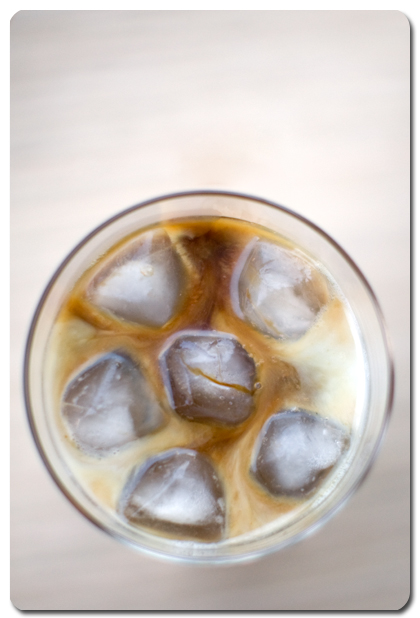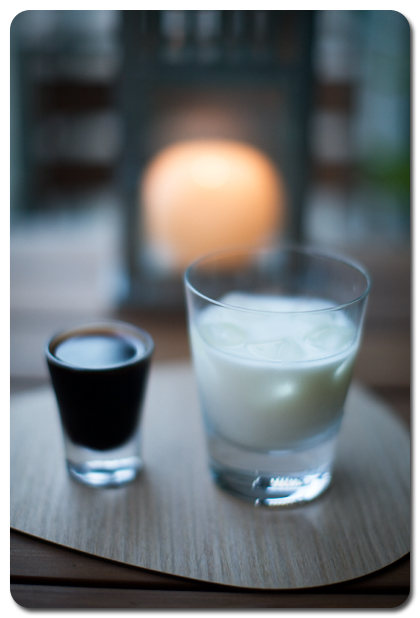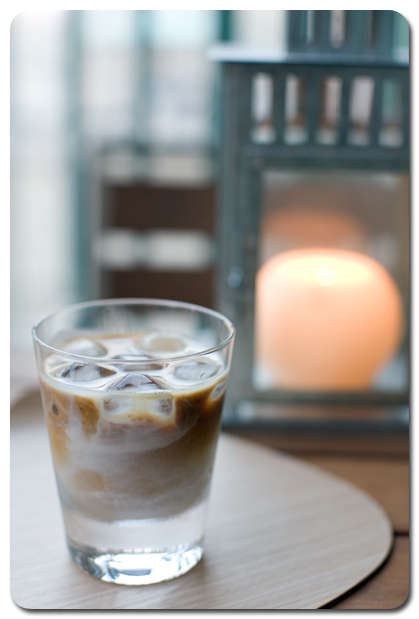Sunday, November 29th, 2009...11:29 am
Ice Cold Brew

I don’t know whether it’s got something to do with the weather – growing up in Singapore meant that I was always in search of an icy-cold drink – or if it’s cos they just taste nicer this way, but I’ve always been an iced coffee kind of girl. I like hot coffee too, especially on a cold morning, in a warm mug that I can wrap my hands around, but given the choice, I always spring for my coffee iced.
I’ve experimented with different ways of making it at home, chilling espresso, making coffee ice cubes, assembling my coffee and sticking it in a pitcher in the fridge to decant as and when I wanted my fix, but a lot of that just ended up being too pernickety: I’d run out of coffee ice cubes, or space in the freezer, and I’d never have the foresight to make a batch of cold coffee to stick in the fridge so I’d always end up dropping a bunch of ice cubes into not-super-cold coffee, making it more diluted than I liked.
Enter Cold Brew coffee – thanks to the neuroses of a similarly obsessive friend of mine. This is a method of making coffee similar to the Toddy Coffee method, but without the Toddy system, of course. Essentially, all you do is mix some medium-coarse ground coffee with water, and let it steep for 12 hours, before straining out the grounds. What you’re left with is a coffee concentrate which you can then dilute with either milk or water, depending on how you like your coffee.

The other great thing about cold brewing is that there’s a much lower percentage of acid and oils extracted from the coffee (the figure of how much acid and oil extracted is somewhere between 15-35%, depending on which internet source you trust more). This means that the coffee doesn’t end up with a bitter/sour aftertaste when you cool it down or keep it for a while. In fact, a batch of cold brew will keep in the fridge for a good two weeks or so (though I’ve never had a batch last that long in my house)! And while, like me, you might be concerned that lower amounts of oils means less aroma and flavour, the full 12 hour steeping time soaks every last bit of coffee-tastic tasting goodness right out of those beans, so you don’t need to worry about an inferior tasting cuppa joe.
And, since it’s already cold, and super concentrated, you don’t need to worry about it melting all your ice cubes. Just factor in the melting ice in your dilution factor while assembling your drink.
The only hiccup I encountered was that while most of the information I found online on the proportions of coffee to water suggested a 1:4 ratio by volume (i.e. say 1 cup of ground coffee to 4 cups of water), the resulting brew I got was much too weak. I did a few experiments and I’ve settled on my perfect ratio, which is 1:4 by weight. It’s also way easier to measure it out by weight, but if you haven’t got a scale, my ratio works out to be around 1:2 or 2:5 by volume.
Also, this coffee that I made was just So Good, I now drink it by the bucketload. I’ve barely even made it to Starbucks for Toffee Nut Latte season!

Cold Brewed Coffee
250g medium-coarse ground coffee
1000ml cold (distilled) water
Weight out the coffee and water into a non-reactive container that has a tight fitting lid (you want to keep other fridge aromas out). Mix well, to ensure that there are no lumps of coffee grounds, then cover.
Allow to steep for at least 12 hours (I’ve left it for about 16 with no huge detriment either), then strain twice – once through a fine-meshed sieve, then the second time through a coffee filter or a sieve lined with muslin/cheesecloth. Store in an air-tight container in the fridge for up to two weeks.
Yield: Around 700ml of cold brew
Awesome Iced Lattes
1 tbsp simple syrup*
150ml whole milk, very cold
1 shot (30ml) cold brew
4-8 ice cubes
Combine all the ingredients and stir well to combine. Enjoy :)
*simple syrup is equal parts of sugar and water by weight, heated on the stove or in the microwave until the sugar fully dissolves and a clear solution is produced.

3 Comments
December 9th, 2009 at 2:18 am
How do you measure your liquids by weight? Do you use a food scale just like for dry ingredients?
December 9th, 2009 at 5:22 am
Hey Caroline, yes I just use the same scale as I use for my dry ingredients – that’s another reason (apart from accuracy) why I love measuring by weight. It’s as simple as getting one big bowl/container, dumping in 250g of coffee, and 1kg of water.
However, 1ml of water is also equivalent to 1g of water, so if it’s easier for you (say, if you don’t own a scale), you could always measure out a litre of water and add that to a 250g pack of store-bought ground coffee. :)
Hope this helps!
December 10th, 2009 at 12:57 am
Thanks! Yes, I really need to get a food scale. It’s one of those things I never think of buying when I’m actually in a kitchen supply store.